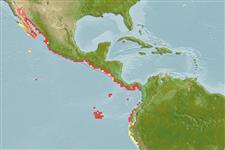Preferred temperature (Referencia
123201): 22.3 - 29.1, mean 26.2 °C (based on 214 cells).
Phylogenetic diversity index (Referencia
82804): PD
50 = 0.5000 [Uniqueness, from 0.5 = low to 2.0 = high].
Bayesian length-weight: a=0.01349 (0.00851 - 0.02138), b=2.91 (2.78 - 3.04), in cm total length, based on LWR estimates for this species & Genus-body shape (Ref.
93245).
Nivel trófico (Referencia
69278): 4.0 ±0.2 se; based on diet studies.
Resiliencia (Referencia
120179): Medio, población duplicada en un tiempo mínimo de 1.4-4.4 años (K = 0.19; Fec = 66,400).
Prior r = 0.57, 95% CL = 0.37 - 0.85, Based on 1 data-limited stock assessment.
Fishing Vulnerability (Ref.
59153): Low to moderate vulnerability (35 of 100).
🛈
Nutrients (Ref.
124155): Calcium = 28.4 [17.6, 41.8] mg/100g; Iron = 0.327 [0.204, 0.502] mg/100g; Protein = 18.8 [17.3, 20.2] %; Omega3 = 0.127 [0.086, 0.183] g/100g; Selenium = 71.2 [46.4, 111.1] μg/100g; VitaminA = 88 [17, 326] μg/100g; Zinc = 0.362 [0.282, 0.513] mg/100g (wet weight);
